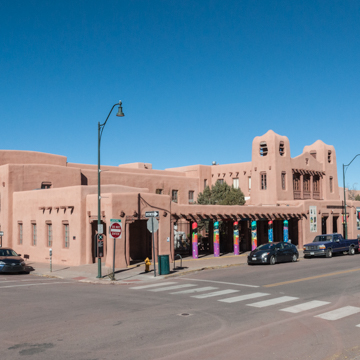You are here
Museum of Contemporary Native Arts
The Federal Building of 1920–1922 adopts the Santa Fe or Spanish-Pueblo Style that the Museum of New Mexico had formulated with its restoration of the Palace of the Governors (1909–1913) and construction of the Museum of Fine Arts (1916–1917). This application of a regional idiom to the protocols of a government building further legitimized the style’s identity as the appropriate image for New Mexico.
The building was designed in Washington, D.C., by the architectural office of James A. Wetmore, Supervising Architect of U.S. Treasury. Its modern structure of brick and reinforced concrete is laid out symmetrically as a series of intersecting axes to form a double-H: the central, two-story pavilion connects via two-story bars to lateral wings that frame square courtyards. The side elevations step down in height from two stories to one, meeting the continuous portico that fronts the building and pulls together the complex massing into a unified composition.
This typical Beaux-Arts plan is effectively camouflaged by the Santa Fe Style. Based on information and images sent by Edgar Lee Hewett, director of the Museum of New Mexico, the architects modeled the facade after the portico of Palace of the Governors and its central pavilion after the auditorium of Museum of Fine Arts. Finished with wooden posts and vigas, sculpted profiles and parapets, and tan cement stucco, the Federal Building represents itself as a direct descendant of seventeenth-century Spanish Colonial missions. Built outside the Plaza and across from the Neo-Romanesque cathedral of Santa Fe, it turns away from such obviously alien European imports to look instead to the invented regionalism of a reimagined past.
The Federal Building originally housed a post office and government offices. In 1990–1992, it was renovated and its interior remodeled to serve as the Museum of Contemporary Native Arts for the Institute of American Indian Arts (IAIA). Because the building’s function was always divorced from its architectural form, this repurposing has been seamless, even if it conflates Native Americans with Spanish colonizers. Ironically, the Santa Fe Style has come to seem so authentic that the truly indigenous people of New Mexico have appropriated the idiom for themselves.
The museum and educational center is open to the public during regularly scheduled hours.
References
Bell. Wayne, “The Federal Building,” Santa Fe County, New Mexico. National Register of Historic Places Inventory–Nomination Form, 1973. National Park Service, U.S. Department of the Interior, Washington, D.C.
Wilson, Chris. The Myth of Santa Fe: Creating a Modern Regional Tradition. Albuquerque: University of New Mexico Press, 1997.
Writing Credits
If SAH Archipedia has been useful to you, please consider supporting it.
SAH Archipedia tells the story of the United States through its buildings, landscapes, and cities. This freely available resource empowers the public with authoritative knowledge that deepens their understanding and appreciation of the built environment. But the Society of Architectural Historians, which created SAH Archipedia with University of Virginia Press, needs your support to maintain the high-caliber research, writing, photography, cartography, editing, design, and programming that make SAH Archipedia a trusted online resource available to all who value the history of place, heritage tourism, and learning.














